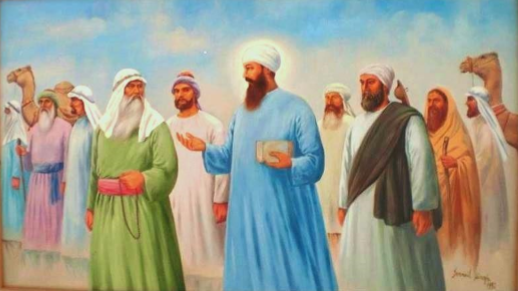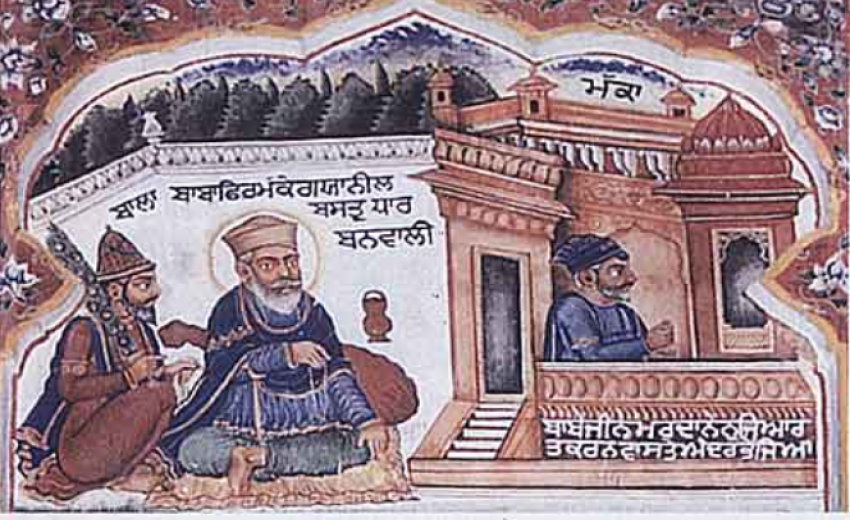Taajudin’s Diary
Foreword by Harbans Lal, PhD; D.Litt. (hons)
I feel flattered over the opportunity to write this prologue to the book that describes Guru Nanak’s travel to far off countries that were the mainstay of Muslim culture and Islamic religion. Guru Nanak attached great importance to this mission of his. The present book describes Guru’s journey to Middle Eastern countries and gives introductions to his visits to some other places. It details many dialogues that the Guru had with Muslim clergy and their followers.
The book begins with Cover Page as below and continues with other chapters:

Account of a Muslim author who accompanied
Guru Nanak from Mecca to Baghdad
By Sant Syed Prithipal Singh ne’ Mushtaq Hussain Shah (1902-1962)
as Edited and Translated by Inderjit Singh
When Guru Nanak Appeared on the World Scene
When Guru Nanak came into this world, the paths to enlightenment were devoid of divinity; they have been thoroughly distorted towards the unholy goals of the exploiters of people. They were mostly selfserving. The powerful who often pretended to protect and to spread their faith actually led to struggles that could only be resolved through the subjugation of the other.
Thus, they routinely resulted in bloody conflicts. Further, there was a score of instances where the rulers chose to protect their own skin by staying aloof that amounted to letting the mighty prevail.
The religious leaders routinely concocted rituals and practices to thrust on people to serve unholy interests and self-serving. These interests were mutually supportive, and they always succeeded in scheming a variety of concealed tricks to fool people who were seeking peace and salvation. The religious institutions had devised beauty shows with religious practices that were intended to attract innocent minds. For example, they invented deities with accompanying stories, idols with descriptions of their powers, recitations to invoke imaginary gods, and rituals that buttressed each other. They asked people to erect stunning buildings to house gods and promised accessibility to gods at precise times, and places opened only through the expense of wealth, time in subjugation, and energy. As an example of these schemes, the sacred institution of altruism was so perverted that it only benefited the clergy and their enterprises.
Many other tricks were employed to speed a religion’s institutional agenda. For example, miracles were invented to convert people and to influence human behaviors. The religious myths were designed to answer real questions and then safeguarded those cleverly devised myths by un-testable threats and promises. Further, organized religious institutions established cults of visible marks and body wrappings to encourage hatreds, murders, and wars against those who did not toe the line, or who were associated with the competing religions.
People were asked to invest a massive amount of money, time, and mind in ritualistic illusions and also in corrupted beliefs such as, either converting others or serving clergy with wealth and flesh that would guarantee heavens that no one had ever seen. Above all, they used horrific fears to ensure compliance to their tricks.
Guru Nanak’s Travel
Guru Nanak came out of his enlightening meditation at the Veni River with fervent zeal to spread what he said was inspiration from the ONE CREATOR MANIFESTED IN ALL. He assigned a symbol of (Ek-Onkaar) to represent the Creator. He termed the calling as to spread the universal message of naam, daan, isnaan. His message meant a lot of theology, but it is sufficed to paraphrase it here as the Mind of Enlightenment, the Culture of Altruism and Thankfulness, and, the Ethics of Good Deeds.
To accomplish his mission, Guru Nanak undertook four long journeys over a period of thirty-five years. He traveled over 30,000 miles in over thirty years. Two faithful provided companionship; Bala, originally from a Hindu background and Mardana, coming from Muslim upbringing.
The countries he covered included, India, Bangladesh, Bhutan, Pakistan, Tibet, Nepal, south-west China, Afghanistan, Iran, Iraq, Saudi Arabia, and Ceylon. Stories of his contacts are continually being discovered from sources in Egypt, Israel, Jordan, Syria, and Rome.
Guru Nanak’s Mission Was Outright Universal
What is universal? Universal is that applies universally, that is, for "all similarly situated individuals," regardless of geography, culture, race, gender, religion, nationality, or any other distinguishing feature.
When one looks at Guru Nanak’s travels, his teachings and life styles, it becomes evident right away that his visions, concerns, and approaches were all universal. Let me explain the universality of Nanak’s mission a bit more as most of us as yet have not grasped the distinction between universal and ethnic.
One of our community leaders was visiting the USA sometimes ago. In our conversation over what he observed he stated his great gratification in this way. He said he was so pleased to see that Sikhism was actually becoming very universal. No matter where he traveled, he always met Sikhs, and they were all flourishing. To him, it was not always like during his prior visits. I responded that his observation of meeting Punjabi ethnic Sikhs everywhere was correct and was heartening, but Sikhi was not at all going universal. No matter how many Punjabi Sikhs he found in how many unexpected places, this, itself did not bring universality to Sikhi.
Rather, Sikhi would be universal only when the teachings of our Guru would have everyday appeal to civil societies in many countries within and beyond where Guru Nanak was born. It will be universal when it is practiced by many diverse cultures across the oceans.
A universal is something -- maybe a practice, a concept, an idea, a feeling, etc. -- that can be shared in practice across different cultures and languages. When the ideas or teachings can be readily exported beyond the domain in which it originated, independent of transporting people who practiced those concepts, only then, Sikhi values have become universal.
For example, Christians have exported the idea of “God’, or ‘religion’ beyond its origins in the MiddleEastern and Greco-Roman context. As a result, Native Americans, Black Africans and Caucasian alike have accepted Christianity. Western secularists have exported the idea of democracy beyond its European and American context. Buddhists and Hindus have exported the concepts of dharma, karma, meditation, yoga, and transmigration, beyond India. There are much more examples of the values that have earned the ranks of universality. Such is not yet the case with the Sikhi values.
Such was precisely the objective of Guru Nanak and his mission; to take his message across oceans and mountains to civil societies everywhere. Prevalence of similar cultures, languages, particularly religious beliefs, weather, landscapes, business opportunities, or political system was not a requirement to entice Guru Nanak to visit a given location. He had no plans to export or take with him any ethnic peoples or languages to the places he would select to visit. His whole object was to promote dialogues with religious people and promote interfaith engagement all over the globe towards the universal pathways to enlightenment (NAAM), to the culture of altruism and thanksgiving (DAAN), and the ethics of goodness (ISHNAAN). All this becomes apparent when one examines the Guru’s dialogues and his travels judiciously.
First of all, Guru Nanak saw serious problems with the civil societies the world over. His objective was clearly to stir the hearts and minds of people everywhere and all over the world. Bhai Gurdas, the Sikh theologian of the highest repute, witnessed this in the following verse.
ਬਾਝਹੁ ਗੁਰੂ ਗੁਬਾਰ ਹੈ, ਹੈ ਹੈ ਕਰਦੀ ਸੁਣੀ ਲੁਕਾਈ।
ਬਾਬੇ ਭੇਖ ਬਣਾਇਆ ਉਦਾਸੀ ਕੀ ਰੀਤਿ ਚਲਾਈ।
ਚੜ੍ਹਿਆ ਸੋਧਣਿ ਧਰਤਿ ਲੁਕਾਈ ॥੨੪॥
Gurdas –Vaar 1, Pauri 24, Stanza 7.
Baba Guru Nanak gave lots of thought to the prevailing conditions of all humanity.
In his meditation, Baba witnessed the whole earth burning
(with the fire of lust and exploitation). Without the mind of
enlightenment, there was the utter darkness of ignorance and falsehood,
and he heard the cries from all civil societies.
To help the people, Guru Nanak donned robes of a traveling reformer and expounded people of many lands to move into the enlightened minds to overcome their darkness. Thus he traveled extensively to win the humanity with extensive dialogues, love, and reasoning.
Guru Arjan then vouched that Guru Nanak’s teachings could be universally practiced by all four distinctive cultures of Hindu Society. The Indian society was divided into, namely, the Kshatriyas who were the nobility and the protectors of society., the Brahmans who provided education and religious leadership, the Vaishya who produced, and the Shudras who served other sections of society through menial jobs. He was very vocal in saying that,
Guru Nanak’s teachings were the same to all four layers of society
(as against the discriminatory provisions of education)
for Kshatriyas, Brahmans, Vaishya, and Shudras.
The Book Story
Acquaintance with Syed Prithipal Singh
During my high school in Haripur Hazara, before the Partition of India, I had the opportunity to meet Syed Prithipal Singh. He was a learned scholar who visited our town periodically during his lecture tours of Pothohar areas. He was a favorite speaker so much so that many Muslim friends used to come to Gurdwara to listen to him.
I vividly recall his presentations in the evening gatherings which were organized in front of our Gurdwara, Guru Nanak Satsang Sabha, Haripur. Space inside the Gurdwara was insufficient to accommodate the large sizes of audience. Thus, the road in front was barricaded to traffic, and rugs were spread on the roads for the audience to sit. His popularity was partly on account of his telling us the stories of Guru Nanak’s visits to Saudi Arabia and other Middle Eastern countries. In his speeches, he often quoted Guru Nanak in Arabic and in Persian.
I was one of his many admirers, first while I lived in Haripur, and later in Patiala after the Partition of India. It is from those days that I longed for a book to describe Guru Nanak’s travels to Makkah and Medina as Syed Sahib used to narrate.
Discovery by Sardar Mangal Singh
After migrating to the USA in 1956, I first returned to visit India in 1963. Then I paid a visit to Sardar Bahadur Mangal Singh. He was a kind friend and the President of the Chief Khalsa Divan, a premier Sikh organization. He suddenly asked me if I could visit a village with him. There a saint Baba had a handwritten manuscript that I should examine and advise him on its publication. I agreed and accompanied him the following day to the village after many hours of a car journey. Sant ji who wore white clothes, I did not recognize him then as my old friend, Syed Sahib. The saintly figure brought a hand written document, several pages thick drafted in Gurmukhi script with black ink for our inspection.
I hurriedly went through the manuscript. I concluded to Sardar Mangal Singh that it was a handwritten account or a diary written in Punjabi about Guru Nanak’s visit to Makkah. It recorded Guru’s dialogues with Islamic leaders there. I was thrilled to see this document. My advice to Sardar Sahib was that the manuscript should be cautiously preserved for research and be published if possible after it is viewed by other historians for its authenticity. I do not remember anything further about the contents except some questions asked of Guru Nanak about his religion and about the future of the world’s religions. I recall Guru Nanak predicting that the Gurmat under multiple names would be the ultimate religion of the world. I also remember noticing the term “Khalsa” used in the manuscript.
Professor Kulwant Singh’s Treatise
During my visit to Amritsar in the year 2000, I met my old colleague Professor Kulwant Singh. He took me to his home and gifted me his book on the Guru Nanak’s visit to Makkah and Medina. He told me that it took him almost 20 years to publish that book as it was a tedious journey to locate and search over a dozen or so research manuscripts.
His book ‘Makkah Medina Di Gosht’ is widely referenced in the present book done by Inderjit Singh. It referenced 17 different old documents and 365 questions and answers between Guru Nanak and his audience. During the further conversation, Professor Sahib told me of other books and documents on this subject.
Sardar Inderjit Singh is very comprehensive in his account as he referenced almost all of the known manuscripts on the subject.
Generosity of Mohinder Singh Bedi
I had lost track of my longtime friend Mohinder Singh Bedi until I read Sardar Himmat Singh’s account of Guru Nanak’s visit to Makkah. I called Himmat Singh in Patiala as he was an old colleague and asked for Sardar Mohinder Singh Bedi’s contact. You will read all about Bedi Sahib in the book under review.
I immediately contacted Bedi Sahib in London and accepted his invitation to visit him there personally to explore further the project of doing a book on Guru Nanak’s travels to Makkah. When visiting him, I understood Bedi Sahib’s apprehension in handing over the treasure he so carefully preserved to anyone without being assured that it would not be exploited either for making money or taking any other kind of dubious advantage. He was also committed to preserving its purity and authenticity.
Both, Bedi Sahib and his wife Kuldip Kaur, were very hospitable when I visited as their guest in London. Bedi Sahib virtually handed over to me everything he had. They were handwritten diaries and documents, some photographs and audiotapes. I did not take with me anything, but together we made arrangements for the documents to be scribed, typed and then translated into English for publication.
A portion of the archival material of Syed Sahib had to be obtained from Patiala, which took considerable time and efforts. Dr. Himmat Singh of Patiala and Sardar Gurmeet Singh of London had a great deal to do with transcription of the documents.
As and when we received the documents we passed them on to Sardar Inderjit Singh who had earlier offered to translate everything in English and typeset it in a book form. The result of Inderjit’s labor is in your hand.
Inderjit was enthusiastic and very charitable to translate the portions that he first rendered into a coherent story for publication, all done as a team with Bedi Sahib and others involved at all stages. Inderjit’s is the first effort to tell the story in English as it was extracted from the hand written material left behind by Syed Prithipal Singh. There are other materials also left behind by Syed Sahib and collected by his son, Mohinder Singh Bedi. Hopefully, scholars would come forward to research those material and bring them to public’s attention soon.
A Significant Book
The book is essentially a diary of Guru Nanak’s travels to the Islamic world by the Arab followers of the Guru. Syed Prithipal Singh deserves credits for recognizing its value and collecting from the Arabian sources. He is entirely responsible for the verification and its evidence. Also, the translator being a Sikh may not be familiar with some terms that may appear to belittle the Quran or the Prophet. We Sikhs respect all religions and their sacred scriptures. There is no intention to belittle any one, any prophet or any scripture or hurt any feelings. If anything looks like a sacrilege even distantly, it is not intentional, and everyone involved in the project offers genuine regret and apology.
This book is the latest effort first to collate and preserve the evidence as well as the universal teachings of Guru Nanak. The evidence to support the Guru’s travels through the Middle East is substantial. It is unfortunate that a lot of the physical evidence (buildings, stone tablets, manuscripts, etc.) is being destroyed either purposefully or through mere neglect. The Guru’s monument at Baghdad was accidentally destroyed during the aftermath of the Iraqi invasion by the US in 2003. We are, however, content with the assurance given to us that it would be repaired and restored after the war in Iraq ends.
In Saudi Arabia, especially around Makkah and Medina, the Wahhabi influence has systematically destroyed religious and historical sites which did not fit their perception of Islam. In this pursuit, Wahhabis didn’t even spare some Islamic heritage itself and evidence linked to the Prophet and his family. "The Wahhabi clergy (body of religious scholars) viewed local religious practices as unfounded superstition superseding codified religious sanction that was considered a total corruption of religion and the spreading of heresy. What followed was a removal of the physical infrastructure, tombs, mausoleums, mosques, and sites associated with the family and companions of Prophet Muhammad.1 " In the process, the evidence of the relationship of Islam with other world’s religions as the path shown by Guru Nanak was also eclipsed.
Thus, it is more important to research and document history related to Guru Nanak before all traces of evidence of his visit is entirely destroyed. The writer has compiled some of this evidence in the Appendix of this book.
Recommendation
Both scholars and laity will benefit from the most recent treatise on the travels of Guru Nanak collated and translated by Inderjit Singh. It is suitable for research on Guru Nanak’s mission and his travels. No reader will miss noticing the amount of work and dedication that Inderjit put into completing this project.
There are points scattered here and there in this book that may seem to be not consistent with Guru Nanak’s teachings as we perceive them today. For example, there are references to “karamat” or miracles by the Guru; there are citations from sources yet not confirmed, and there are included selected verses from Holy Quran. However, the author himself realized those limitations by saying that he might not agree with all of the observations of Syed Prithipal Singh such as a reference to some chapters in Dasam Granth, reference to some karamats, etc. or any unintended slur to Holy Quran. I too join the author in disclaiming anything quoted in the book that is even indirectly disrespectful to Islamic or Sikh literature or scriptures. Any slur was unintentional to be disrespectful.
This book is very timely because, Sikhs stand at a new juncture, new crossroads. This book gives a glimpse of how Guru Nanak welcomed the globalization and showed a path to make use of such a globalization with a message that is really universal. It is upon all of us to welcome the citizenship of the global village and rearticulate Guru’s teaching as universal values.
ਪਰਥਾਇ ਸਾਖੀ ਮਹਾ ਪੁਰਖ ਬੋਲਦੇ ਸਾਝੀ ਸਗਲ ਜਹਾਨੈ ॥ SGGS, p. 647
Great sages speak the lessons by relating them to specific
situations, but the message is to be shared by all.
We are challenged to realize a form of subjectivity that is genuinely plural and is in consonance with the message of Guru Nanak. This way we follow Guru Nanak’s footsteps and encounter the coming waves of global uncertainty with confidence and optimism. Ignoring the path that Guru Nanak showed through his travels and dialogues with every religion in favor of heresy stories or Sakhies will retreat us into the usual kind of romantic self-emulation.
Harbans Lal, Ph.D., D.Litt. (Hons)
Biblio:
1 Rentz, George S. (2004). "Devotion". The Birth of the Islamic Reform Movement in Saudi Arabia. London: Arabian Publishing Ltd. p. 139. The Wiki site http://en.wikipedia.org/wiki/Destruction_of_early_Islamic_heritage_sites_in_Saudi_Arabia provides a partial list of famous mosques and sites destroyed by Wahhabis. The list includes some of the sites referenced by Sant Prithipal Singh in this book. For example, the Tomb of Eve in Jeddah was sealed with concrete in 1975






